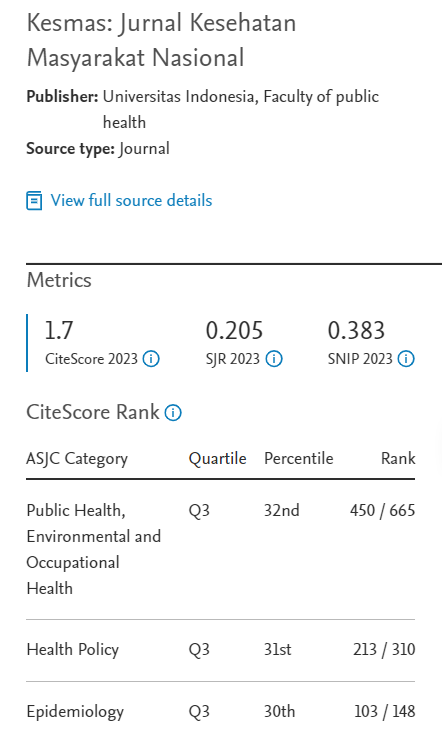Abstract
Salah satu bentuk medikalisasi kelahiran adalah angka persalinan sectio caesarea yang tinggi. Hasil beberapa studi menunjukkan bahwa dokter ahli kebidanan dan kandungan merupakan faktor penting yang menentukan persalinan yang dijalani responden. Penelitian ini bertujuan menilai perandokter ahli kebidanan dan kandungan dalam mengambil keputusan untuk melakukan sectio caesarea dibandingkan persalinan normal dengan mengontrol variabel sosiodemografi dan faktor risiko ibu. Penelitian dilakukandengan metode cross sectional menggunakan data Survei Demografi dan Kesehatan Indonesia (SDKI) DKI Jakarta. Populasi penelitian adalah wanita pernah kawin usia 15 - 44 tahun yang memiliki riwayat melahirkan 5 tahun terakhir sebelum survei dilakukan. Hasil penelitian menunjukkanpemilihan petugas pelayanan antenatal berhubungan dengan persalinan sectio caesarea, tetapi hubungan ini tidak berdiri sendiri, terkait dengan pengaruh status ekonomi rumah tangga. Dari penelitian ini disimpulkan bahwa terdapat hubungan yang signifikan antara responden yang memilih dokter ahli kebidanan dan kandungan sebagai petugas pelayanan antenatal dengan persalinan sectio caesarea yang juga dipengaruhi oleh status sosial ekonomi rumah tangga responden. Selain status sosial ekonomi, variabel yang berhubungan dengan persalinan sectio caesarea adalah usiaibu, paritas ibu, pendidikan ibu, riwayat komplikasi kehamilan, dan riwayat perdarahan.
One of the birth medicalization form is the high number of sectio caesarea deliveries. Result of some studies shows that obstetrician is a factor which can determine the preference type of delivery. The purpose of this study is to assess the role of the obstectrician in order to make decision making inpreference sectio caesarea delivery than vaginal delivery after controlled with sociodemographic factors and maternal risk factor. The study was a cross sectional study using a quantitative approach. This study using secondary data which obtained from Indonesia Demographic and Health Survey 2007 with subset of the research is DKI Jakarta region. Population of this study was married women with age between 15 - 44 years old who has delivery history in term of 5 years before the survey. The study shows significant correlation between prenatal care workers with sectio caesarea delivery but this correlation also has an interaction with household economic status variables. There is significant correlation between respondent whose prenatal care with obstectrician with sectio caesarea delivery. This correlation also related with household economic status. Others variables related to sectio caesarea delivery beside social economic status are maternalage, parity, maternal education, complication during pregnancy history, and bleeding history.
References
1. Mary N. Kehamilan dan melahirkan. Jakarta: Penerbit Arcan; 2004.
2. Edwards G. Praktik kebidanan kesehatan masyarakat. Jakarta: Penerbit EGC; 2007.
3. Zhang J, Liu Y, Meikle S, Zheng J, Sun W, Li Z. Cesarean delivery on maternal request in Southeast China. Obstetrics Gynecology. 2008; 111: 1077-82.
4. Durham J. Understanding the cesarean epidemic. 2010. Available from: http://www.transitiontoparenthood.com/ttp/parented/laborbirth/cesarean.htm
5. Sarmana. Determinan nonmedis dalam permintaan persalinan sectio caesaria di Rumah Sakit St. Elisabeth Medan [skripsi]. Sumatera Utara: Fakultas Kesehatan Masyarakat Universitas Sumatera Utara; 2004.
6. World Health Organization. World health statistics. Geneva, Switzerland: World Health Organization Press; 2010.
7. Worden J. Too posh too push. 2011. Available from: http://www.netdoctor. co.uk/health_advice/facts/pregnancy_too_posh.
8. Betrán AP, Gulmezoglu AM, Robson M, Merialdi M, Souza JP, Wojdyla D. WHO global survey on maternal and perinatal health in Latin America: classifying caesarean sections. Reproductive Health. 2009; 6:18.
9. MacDorman, Fay M, Eugene D. Cesarean birth in United States: epidemiology, trends, and outcomes. Clinics and Perinatology Journal. 2008; 35 (2): 293-307.
10. Ghosh S. Increasing trend in caesarean section delivery in India: role of medicalisation of maternal health. The Institute for Social and Economic Change, Bangalore, India. Working Paper. 2010: 236.
11. Hutabalian D. Pengaruh faktor internal dan eksternal ibu bersalin terhadap indikasi tindakan sectio caesaria dalam persalinan di Rumah Sakit Umum Daerah Swadana Tarutung [tesis]. Sumatera Utara: Program Studi Ilmu Kesehatan Masyarakat Universitas Sumatera Utara; 2011.
12. Badan Pusat Statistik, Macro International. Survei demografi dan kesehatan Indonesia 2007. Calverton, Maryland, United States of America: Badan Pusat Statistik dan Macro International; 2007.
13. World Health Organization. World health statistics. Geneva: World Health Organization ; 2009
14. Widiatmoko D. Menelisik hubungan penyedia dan pencari layanan kesehatan. 2009. Diakses dari: http://www.io.ppijepang.org/v2/index. php?option=com_k2&view=item&id=335:menelisik-hubungan-penyedia-dan-pencari-layanan-kesehatan.
15. Festin MR, Laopaiboon M, Pattanittum P, Ewens MR, Henderson-Smart DJ, Crowther CA, et al. Caesarean section in four South East Asian countries: reasons for, rates, associated care practices and health outcomes. BMC Pregnancy and Childbirth. 2009; 9:17
16. Gruber J, Owings M. Physician financial incentives and cesarean section delivery. Rand Journal of Economics. 1996; 23: 99-123.
17. Andrea AR. Faktor-faktor yang berhubungan dengan persalinan melalui operasi sesar tahun 1997-2003 (SDKI 2002-2003) [tesis]. Depok: Fakultas Kesehatan Masyarakat Universitas Indonesia; 2005.
Recommended Citation
Meiyetriani E , Utomo B , Besral B ,
et al.
Peran Dokter Ahli Kebidanan dan Kandungan.
Kesmas.
2013;
7(1):
37-43
DOI: 10.21109/kesmas.v7i1.74
Available at:
https://scholarhub.ui.ac.id/kesmas/vol7/iss1/6







